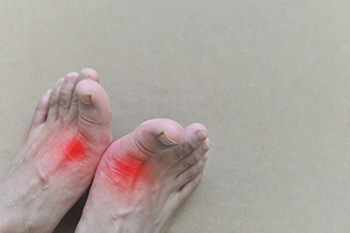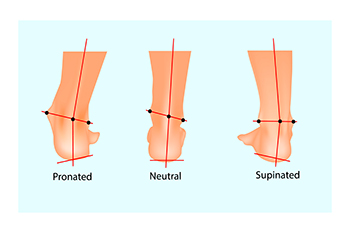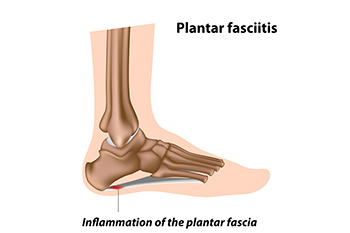Items filtered by date: June 2025
Understanding the Causes and Symptoms of Gout

Gout is a painful form of inflammatory arthritis caused by a buildup of uric acid crystals in the joints, most commonly the big toe. This condition can develop suddenly and is often triggered by dietary choices, genetics, or underlying health issues. Risk factors include cardiovascular disease, diabetes, diuretic use, obesity, and elevated triglyceride levels. Symptoms of gout include intense joint pain, redness, swelling, and warmth, often described as feeling like the toe is on fire. The joint may become so tender that even the weight of a bedsheet feels unbearable. A podiatrist plays a vital role in diagnosing and managing gout. Through physical examination, imaging, and lab tests, they can confirm the condition and offer relief through medication, dietary guidance, and preventive strategies to manage flare-ups and avoid joint damage. If you are dealing with this condition, it is suggested you make an appointment with a podiatrist for evaluation and treatment.
Gout is a foot condition that requires certain treatment and care. If you are seeking treatment, contact Christopher Murphy, DPM from Murphy Foot and Ankle Medicine and Surgery. Our practitioner will treat your foot and ankle needs.
What Is Gout?
Gout is a type of arthritis caused by a buildup of uric acid in the bloodstream. It often develops in the foot, especially the big toe area, although it can manifest in other parts of the body as well. Gout can make walking and standing very painful and is especially common in diabetics and the obese.
People typically get gout because of a poor diet. Genetic predisposition is also a factor. The children of parents who have had gout frequently have a chance of developing it themselves.
Gout can easily be identified by redness and inflammation of the big toe and the surrounding areas of the foot. Other symptoms include extreme fatigue, joint pain, and running high fevers. Sometimes corticosteroid drugs can be prescribed to treat gout, but the best way to combat this disease is to get more exercise and eat a better diet.
If you have any questions, please feel free to contact our offices located in Edgewater Port Orange . We offer the newest diagnostic and treatment technologies for all your foot care needs.
Explaining Supination of the Foot

Supination of the foot is a natural motion that occurs when the foot rolls outward during walking or running. This helps the foot form a stable structure for push-off. When this motion becomes excessive, it is called over-supination or underpronation. Too much outward rolling can place stress on the outer edge of the foot and reduce shock absorption. This may lead to heel pain, ankle sprains, arch strain, and fractures in the heel bone. Over-supination is often related to high arches, poor walking patterns, or previous foot injuries. People who over-supinate may notice that their shoes wear out more along the outer edges, causing instability while walking. A podiatrist can evaluate your gait and determine if your foot alignment is contributing to the pain. Custom orthotics, bracing, or surgery may be recommended to correct the issue and improve balance. If you have foot pain caused by your gait, it is suggested that you schedule an appointment with a podiatrist for an exam and appropriate treatment options.
If you have any concerns about your feet, contact Christopher Murphy, DPM from Murphy Foot and Ankle Medicine and Surgery. Our practitioner can provide the care you need to keep you pain-free and on your feet.
Biomechanics in Podiatry
Podiatric biomechanics is a particular sector of specialty podiatry with licensed practitioners who are trained to diagnose and treat conditions affecting the foot, ankle and lower leg. Biomechanics deals with the forces that act against the body, causing an interference with the biological structures. It focuses on the movement of the ankle, the foot and the forces that interact with them.
A History of Biomechanics
- Biomechanics dates back to the BC era in Egypt where evidence of professional foot care has been recorded.
- In 1974, biomechanics gained a higher profile from the studies of Merton Root, who claimed that by changing or controlling the forces between the ankle and the foot, corrections or conditions could be implemented to gain strength and coordination in the area.
Modern technological improvements are based on past theories and therapeutic processes that provide a better understanding of podiatric concepts for biomechanics. Computers can provide accurate information about the forces and patterns of the feet and lower legs.
Understanding biomechanics of the feet can help improve and eliminate pain, stopping further stress to the foot.
If you have any questions please feel free to contact our offices located in Edgewater Port Orange . We offer the newest diagnostic and treatment technologies for all your foot and ankle needs.
Risk Factors of Ankle Sprains in Athletes

An acute ankle sprain occurs when the foot twists or rolls in an unnatural way. The term acute means that the injury happened recently and suddenly, rather than over time. Athletes involved in sports that involve jumping, quick direction changes, or uneven surfaces are more at risk. An acute ankle sprain causes immediate pain, swelling, and difficulty walking. Most acute sprains affect the ligaments on the outside of the ankle, particularly the one that connects the outer ankle bone to the foot. Ligaments help keep the ankle stable, and when they are stretched or torn, the ankle can become weak or unstable. Without proper care, athletes risk repeated sprains and long-term problems like chronic pain or joint stiffness. A podiatrist can determine the severity of the ankle injury, recommend bracing or walking support, and discuss surgery, if needed. If you have sprained an ankle, it is suggested that you make an immediate appointment with a podiatrist.
Ankle sprains are common but need immediate attention. If you need your feet checked, contact Christopher Murphy, DPM from Murphy Foot and Ankle Medicine and Surgery. Our practitioner can provide the care you need to keep you pain-free and on your feet.
How Does an Ankle Sprain Occur?
Ankle sprains take place when the ligaments in your ankle are torn or stretched beyond their limits. There are multiple ways that the ankle can become injured, including twisting or rolling over onto your ankle, putting undue stress on it, or causing trauma to the ankle itself.
What Are the Symptoms?
- Mild to moderate bruising
- Limited mobility
- Swelling
- Discoloration of the skin (depending on severity)
Preventing a Sprain
- Wearing appropriate shoes for the occasion
- Stretching before exercises and sports
- Knowing your limits
Treatment of a Sprain
Treatment of a sprain depends on the severity. Many times, people are told to rest and remain off their feet completely, while others are given an air cast. If the sprain is very severe, surgery may be required.
If you have suffered an ankle sprain previously, you may want to consider additional support such as a brace and regular exercises to strengthen the ankle.
If you have any questions please feel free to contact our offices located in Edgewater Port Orange . We offer the newest diagnostic tools and technology to treat your foot and ankle needs.
Plantar Fasciitis and Podiatry Care

Plantar fasciitis is caused by inflammation of the plantar fascia, the thick band of tissue that runs along the bottom of the foot and supports the arch. This condition often leads to sharp heel pain, especially with the first steps in the morning or after long periods of rest. Risk factors include prolonged standing, flat feet, high arches, obesity, and wearing footwear that lacks proper support. Symptoms include aching, stiffness, or a burning sensation in the heel. If left untreated, the pain can become chronic and interfere with daily activities. A podiatrist can diagnose plantar fasciitis, provide targeted stretching exercises, and offer custom orthotics or treatments to relieve pain and promote healing. If you have heel pain, it is suggested that you consult a podiatrist who can accurately diagnose and treat the condition.
Plantar fasciitis can be very painful and inconvenient. If you are experiencing heel pain or symptoms of plantar fasciitis, contact Christopher Murphy, DPM from Murphy Foot and Ankle Medicine and Surgery. Our practitioner can provide the care you need to keep you pain-free and on your feet.
What Is Plantar Fasciitis?
Plantar fasciitis is the inflammation of the thick band of tissue that runs along the bottom of your foot, known as the plantar fascia, and causes mild to severe heel pain.
What Causes Plantar Fasciitis?
- Excessive running
- Non-supportive shoes
- Overpronation
- Repeated stretching and tearing of the plantar fascia
How Can It Be Treated?
- Conservative measures – anti-inflammatories, ice packs, stretching exercises, physical therapy, orthotic devices
- Shockwave therapy – sound waves are sent to the affected area to facilitate healing and are usually used for chronic cases of plantar fasciitis
- Surgery – usually only used as a last resort when all else fails. The plantar fascia can be surgically detached from the heel
While very treatable, plantar fasciitis is definitely not something that should be ignored. Especially in severe cases, speaking to your doctor right away is highly recommended to avoid complications and severe heel pain. Your podiatrist can work with you to provide the appropriate treatment options tailored to your condition.
If you have any questions, please feel free to contact our offices located in Edgewater Port Orange . We offer the newest diagnostic and treatment technologies for all your foot care needs.
